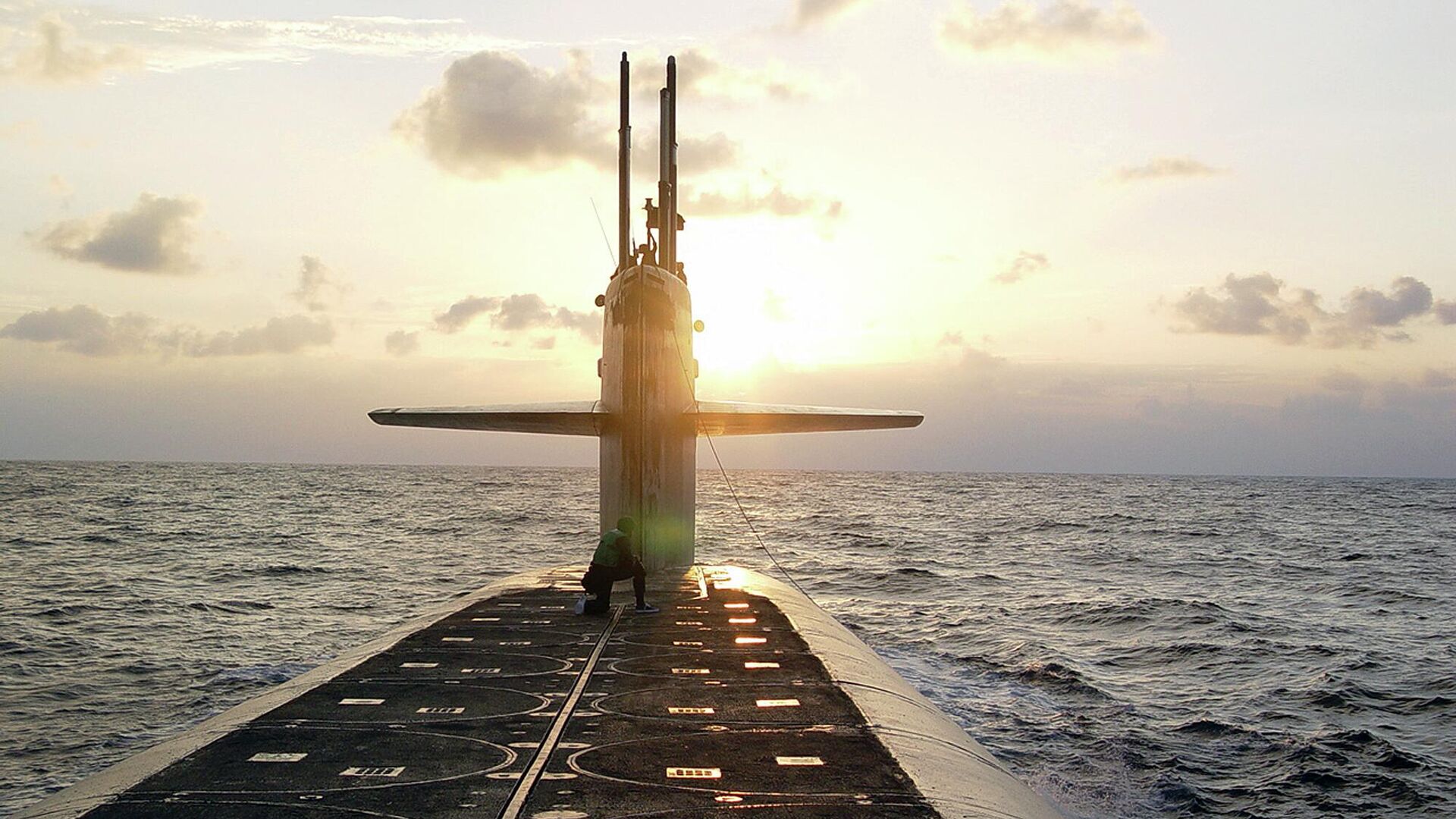https://sputnikglobe.com/20220811/stratcom-head-us-working-furiously-to-formulate-new-deterrence-strategy-against-russia-china-1099494374.html
STRATCOM Head: US Working 'Furiously' to Formulate New Deterrence Strategy Against Russia, China
STRATCOM Head: US Working 'Furiously' to Formulate New Deterrence Strategy Against Russia, China
Sputnik International
The STRATCOM chief has given the first-ever real-world commander's estimate of what it would take to prevent nuclear war as events in Ukraine unfolded this... 11.08.2022, Sputnik International
2022-08-11T23:36+0000
2022-08-11T23:36+0000
2022-10-19T20:03+0000
military
us
nuclear
nuclear weapons
deterrence
russia
china
stratcom
us navy
https://cdn1.img.sputnikglobe.com/img/07e6/08/0b/1099495217_0:0:2000:1125_1920x0_80_0_0_04a7eba3693142b900066507d93f305b.jpg
The chief commander of the US nuclear arsenal stated that the country is "furiously" drafting a new nuclear deterrence theory that includes a simultaneous confrontation with Russia and China, the Defense One news website reported on Thursday.Speaking at the Space and Missile Defense Symposium in Alabama, US Strategic Command (STRATCOM) head Navy Adm. Chas Richard added that more Americans need to be working on ways to prevent nuclear conflict. According to Richard, officials at STRATCOM have been responding to how threats from Moscow and Beijing have changed this year.Richard also pointed out that institutional knowledge on preventing nuclear war has waned, necessitating a new deterrence theory.According to the report, this spring, the US sent nuclear command post teams on prolonged aerial missions aboard its E-6 Mercury "Looking Glass" aircraft, which are modified Boeing 707s. Military leaders also made an effort to align the other combatant commands on how to tame and control Russian efforts, particularly in Ukraine. The traditional nuclear deterrence theory of "mutually assured destruction," which holds that any use of nuclear weapons would result in retaliatory use and complete annihilation of all parties, was reportedly also transformed by STRATCOM. The original theory has successfully deterred nuclear conflict for almost 75 years.And the reason for the US high military command to make changes to the previous doctrine is said to be the February statement of Russian President Vladimir Putin, who warned the collective West against intervening in the Russian special military operation in Ukraine, threatening that such actions would have "catastrophic" consequences.Though US military officials do not anticipate a full set of nuclear weapons will be utilized, they are reportedly concerned Russia may launch a limited nuclear war they have long feared instead by using smaller warheads on certain targets.Such perceived threats reportedly forced STRATCOM to change its course of action.Richard stressed, however, that those plans were only "a two-party version." This supposedly ignores US concerns about China's hypersonic technology that could carry nuclear warheads, Beijing aspirations for Taiwan, the lessons China is learning from the West's response to the Ukrainian crisis, or the possibility China and Russia could combine their ambitions in a way that would force the US to contend with multiple nuclear threats.However, despite all the worries about the hypothetical first use of nuclear weapons by Russia or China, it is the United States that remains the only country to actually use them against people.US B-29 aircraft dropped atomic bombs on the Japanese cities of Hiroshima and Nagasaki in August 1945. The atomic explosion and its aftereffects caused about 140,000 deaths in Hiroshima and 74,000 deaths in Nagasaki. Civilians made up the great bulk of the atomic explosions' victims.
https://sputnikglobe.com/20220802/russian-foreign-ministry-hybrid-war-against-moscow-could-lead-to-a-conflict-between-nuclear-powers-1098052033.html
https://sputnikglobe.com/20220806/aukus-paves-way-for-placing-nuclear-weapons-in-australia-russian-foreign-ministry-says-1098962077.html
russia
china
Sputnik International
feedback@sputniknews.com
+74956456601
MIA „Rosiya Segodnya“
2022
News
en_EN
Sputnik International
feedback@sputniknews.com
+74956456601
MIA „Rosiya Segodnya“
Sputnik International
feedback@sputniknews.com
+74956456601
MIA „Rosiya Segodnya“
us, nuclear, nuclear weapons, deterrence, russia, china, stratcom, us navy
us, nuclear, nuclear weapons, deterrence, russia, china, stratcom, us navy
STRATCOM Head: US Working 'Furiously' to Formulate New Deterrence Strategy Against Russia, China
23:36 GMT 11.08.2022 (Updated: 20:03 GMT 19.10.2022) Kirill Kurevlev
Managing Editor
The STRATCOM chief has given the first-ever real-world commander's estimate of what it would take to prevent nuclear war as events in Ukraine unfolded this winter. However, as tensions with China around Taiwan have risen sharply in the past few weeks, the high command ordered a reassesment.
The chief commander of the US nuclear arsenal stated that the country is "furiously" drafting a new nuclear deterrence theory that includes a simultaneous confrontation with Russia and China, the Defense One news website
reported on Thursday.
Speaking at the
Space and Missile Defense Symposium in Alabama, US Strategic Command (STRATCOM) head Navy Adm. Chas Richard added that more Americans need to be working on ways to prevent nuclear conflict. According to Richard, officials at STRATCOM have been responding to how threats from Moscow and Beijing have changed this year.
"We have to account for three-party [threats],” Richard said at this year's conference. "That is unprecedented in this nation's history. We have never faced two peer nuclear-capable opponents at the same time, who have to be deterred differently."
Richard also pointed out that institutional knowledge on preventing nuclear war has waned, necessitating a new deterrence theory.
"Even our operational deterrence expertise is just not what it was at the end of the Cold War. So we have to reinvigorate this intellectual effort. And we can start by rewriting deterrence theory, I'll tell you we're furiously doing that out at STRATCOM," Richard said.
According to the report, this spring, the US sent nuclear command post teams on prolonged aerial missions aboard its E-6 Mercury "Looking Glass" aircraft, which are modified Boeing 707s. Military leaders also made an effort to align the other combatant commands on how to tame and control Russian efforts, particularly in Ukraine.
The traditional nuclear deterrence theory of
"mutually assured destruction," which holds that any use of nuclear weapons would result in retaliatory use and complete annihilation of all parties, was reportedly also transformed by STRATCOM. The original theory has successfully deterred nuclear conflict for almost 75 years.
And the reason for the US high military command to make changes to the previous doctrine is said to be the February statement of Russian President Vladimir Putin, who warned the collective West against intervening in the Russian special military operation in Ukraine, threatening that such actions would have "catastrophic" consequences.
Though US military officials do not anticipate a full set of nuclear weapons will be utilized, they are reportedly concerned Russia may launch a limited nuclear war they have long feared instead by using smaller warheads on certain targets.
"Moscow is using both implicit and explicit nuclear coercion,” the admiral said. "They're trying to exploit a perceived deterrence gap, a threshold below which they mistakenly believe they may be able to employ nuclear weapons," such as through the use of tactical, shorter-range nukes.
Such perceived threats reportedly forced STRATCOM to change its course of action.
"We've got some better two-party stuff that's actually working quite well in the current crisis that is radically different," he explained. "Non-linearity, linkages, chaotic behavior, inability to predict – all attributes that just don't show up in classic deterrence theory."
Richard stressed, however, that those plans were only "a
two-party version." This supposedly ignores US concerns about China's hypersonic technology that could carry nuclear warheads, Beijing aspirations for Taiwan, the lessons China is learning from the West's response to the Ukrainian crisis, or the possibility China and Russia could combine their ambitions in a way that would force the US to contend with multiple nuclear threats.
"Russia and the PRC have the ability to unilaterally, whenever they decide, they can escalate to any level of violence in any domain. They can do it worldwide and they can do it with any instrument of national power. We're just not used to dealing with competitions and confrontations like that," he asserted.
However, despite all the worries about the hypothetical first use of nuclear weapons by Russia or China, it is the United States that remains the only country to actually use them against people.
US B-29 aircraft dropped atomic bombs on the Japanese cities of Hiroshima and Nagasaki in August 1945. The atomic explosion and its aftereffects caused about 140,000 deaths in Hiroshima and 74,000 deaths in Nagasaki. Civilians made up the great bulk of the atomic explosions' victims.






